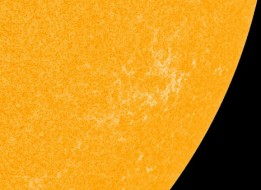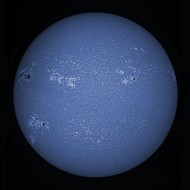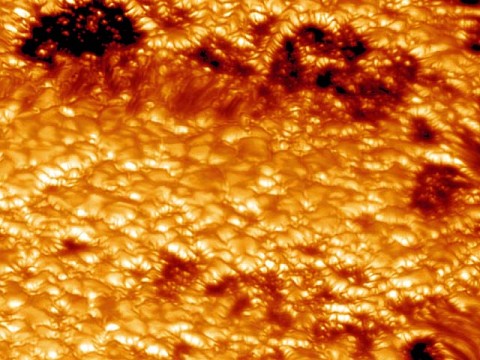Fascinating faculae provide a way for anyone with a small telescope to track the ups and downs of the solar cycle — even when there are no sunspots.

NASA
Sunspots get all the press. Last week the Web hummed with articles about a spotless Sun, the first time since August 2011 our star wore a blank stare. Could a sudden decline in solar activity during an already weak sunspot cycle hint at an earlier than usual minimum?
Possibly. But the Sun's magnetic manifestations have many dimensions. Even when showy sunspots fail to appear, the solar observer can always count on another phenomenon, the often overlooked faculae (pronounced FAK-yuh-lee).
Latin for "little torch." faculae are white spots concentrated around and within sunspot groups. Groups may come and go, but faculae often linger longer or presage the appearance of new spot groups. They can also appear on their own without help from their spotted siblings.
On July 17th, not a single sunspot marred the solar photosphere, but dabs of faculae were clearly visible at various locations along the solar limb or edge. Because they appear bright against the darkened limb, faculae stand out better there than they do nearer the Sun's center, where we peer into a greater depth of hot, glaring gas.

Chris Schur
Any telescope equipped with a safe solar filter can tackle faculae. You don't need high power or ideal seeing conditions. Sweep your eye around the outer fifth of the Sun's disk, paying particular attention to the east and west limbs and sunspot groups in those regions.
Faculae form spidery networks of white patches that can extend for tens of thousands of kilometers. While they thread across the entire disk, contrast with the Sun's dark limb makes them much easier to see along the edge.
Like sunspots, faculae are manifestations of the Sun's seething magnetic energy. Even at solar minimum, when the Sun can remain spotless for days, polar faculae fleck its high latitudes, adding character to an otherwise featureless disk. Their humdrum appearance belies a fascinating origin best appreciated in high-resolution photography.
Like bubbles rising in a pot of boiling water, convection currents from below carry energy generated in the Sun's core to the surface, creating a frothy sea of individual convective cells called granules. Each spans an area the size of Texas and lasts a brief 6 t0 20 minutes. Under good seeing conditions, a small, filter-equipped telescope magnifying 30× will plainly show the finely-textured "ground glass" appearance of granulation.

Goran Scharmer / Royal Swedish Academy of Sciences
Each granule or bubble of hot gas bobs to the surface, spreads out, and releases a tiny fraction of the Sun's heat and light into the vastness of interplanetary space. Cooled by expansion, the gas then sinks back down into the dark valleys separating the granules. Faculae are concentrations of the Sun's magnetic energy that fleck the granules' walls; they're best seen when granules are viewed in profile near the edge of the Sun, giving us a sideways view.

University of Alabama
Faculae appear bright because concentrated magnetic energy makes the solar gases more transparent than otherwise. Our line of sight pierces deeper into the granules where the gas is denser and radiates more intensely. Think of it as staring into glowing coals within their shells of ash.
Sunspot magnetic fields are far stronger, and they cool the surrounding gases so much that the spots appear appear dark in comparison to the photosphere. Faculae are concentrated in much smaller bundles and appear bright instead. They're so plentiful compared to sunspots that they make the Sun 0.1% brighter at solar maximum than at solar minimum.
Anyone with the smallest of telescopes and a proper filter can be privy to the secrets of solar magnetism — one more example of how this amazing universe keeps turning up in your own backyard.
Track a year's worth of sunsets and sunrises — and all the celestial highlights that happen in between — with our annual Skygazer's Almanac.
 0
0








Comments
You must be logged in to post a comment.